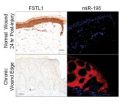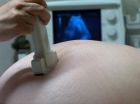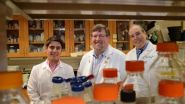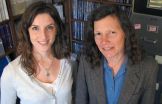(Press-News.org) Patients with diseases such as diabetes suffer from painful wounds that take a long time to heal making them more susceptible to infections that could even lead to amputations. A*STAR's discovery paves the way for therapeutics to improve healing of such chronic wounds, which are a significant burden to patients.
1. Scientists from A*STAR's Institute of Medical Biology (IMB) have identified a molecular "switch" that controls the migration of skin cells necessary for wounds to close and heal. This is especially significant for diabetics and other patients who suffer from chronic wounds, wounds that do not heal or take years to do so, which are vulnerable to infections and could lead to amputations. This switch mechanism may hold the key to developing therapeutics that will reduce or prevent chronic wounds.
2. The scientists discovered that a tiny "micro-RNA" molecule, called miR-198, controls several different processes that help wound healing, by keeping them switched off in healthy skin. When skin is wounded, the manufacture of miR-198 quickly stops and the levels of miR-198 drop, switching on many wound healing processes.
3. In the non-healing wounds of diabetics, miR-198 does not disappear and wound healing remains blocked. This therefore identifies miR-198 as a potential diagnostic biomarker for non-healing wounds. These findings were recently published in the prestigious journal Nature .
4. The research leading to this discovery was carried out in collaboration with A*STAR's Bioinformatics Institute (BII), National University Hospital (NUH), Singapore and Jnana Sanjeevini Diabetes Center, Bangalore, India.
Importance of this discovery
5. Chronic wounds in patients with diabetes are a major global health burden and the most common cause of lower extremity amputations. In Singapore, diabetes is the fifth most common medical condition diagnosed and one in nine people aged 18 to 69 has diabetes. Chronic wounds also tend to affect the elderly and disabled patients, especially those confined to a wheelchair or bed-bound. Unfortunately, chronic wounds are currently poorly understood and insufficiently treated.
6. Dr. Prabha Sampath , principal investigator at IMB and lead author of the paper, said, "Our research provides a comprehensive understanding of the mechanism of the wound healing process. Moving forward, we hope to translate this research into improved patient outcomes. We can now build on this research, to see how we can modulate the defective switch in chronic wounds by targeting miR-198 and its interacting molecules, to develop new strategies for treating chronic wounds."
7. Professor Birgitte Lane, Executive Director of IMB, said, "This switch appears to be an entirely new regulatory component in wound healing, and probably a very important one. Poor wound healing is a major healthcare burden, and this discovery is particularly timely in the face of aging populations and the sharp global rise in diabetes. The finding gives us a platform from which to develop therapies that could significantly reduce chronic wounds and improve healthcare."
An FSTL1-miR-198 molecular 'see-saw' switch.
8. The information necessary to express microRNA-198 (miR-198) and follistatin-like 1 (FSTL1) protein are found in a single "message" produced by the cell. However, miR-198 and FSTL1 protein cannot be produced at the same time – it can only be one or the other. These two molecules also have opposite roles: miR-198 (found in unwounded skin) inhibits skin cell migration and wound healing, whereas FSTL1 protein (expressed after injury) promotes skin cell migration and wound healing. A regulatory switch dictates their expression, and hence controls the "see-saw" between inactive resting skin cells and the cell migration necessary for wound healing.
9. Dr. Sampath and her team showed that healthy unwounded skin contained high levels of miR-198 but no FSTL1 protein. They demonstrated that these high levels of miR-198 prevent skin cell migration by suppressing several genes, such as PLAU, LAMC2 and DIAPH1 , which are needed for different aspects of the wound healing process. However upon injury, miR-198 is switched off in the wound by a signal from transforming growth factor β1 (TGF-β1). This allows FSTL1 to now be made instead, and the skin migration genes to be unblocked, promoting migration of skin cells into the wound area to drive skin wound healing.
10. The scientists further examined skin samples of chronic non-healing ulcer wounds from patients with diabetes mellitus. They observed that, unlike healthy skin that had been injured, there remained high levels of miR-198 (inhibiting skin cell migration and wound healing) and an absence of FSTL1 protein (promoting skin cell migration upon wounding), indicating that this "switch" is defective in chronic wounds. (Annex A)
INFORMATION:
Notes for editor:
The research findings described in this news release can be found in Nature under the title "'See-saw' expression of microRNA-198 and FSTL1 from a single transcript in wound healing" by Gopinath M. Sundaram1,*, John E. A. Common1,*, Felicia E. Gopal1, Satyanarayana Srikanta2, Krishnaswamy Lakshman2, Declan P. Lunny1, Thiam C. Lim3,4, Vivek Tanavde1,5, E. Birgitte Lane1,6,7 & Prabha Sampath1,7. Doi:10.1038/nature11890
1 Institute of Medical Biology, A*STAR, Singapore
2 Jnana Sanjeevini Diabetes Center, India
3 Division of Plastic, Reconstructive & Aesthetic Surgery, NUHS, Singapore
4 Department of Surgery, Yong Loo Lin School of Medicine, NUS, Singapore
5 Bioinformatics Institute, A*STAR, Singapore
6 Department of Pathology, Yong Loo Lin School of Medicine, NUS, Singapore
7 Department of Biochemistry, Yong Loo Lin School of Medicine, NUS, Singapore
AGENCY FOR SCIENCE, TECHNOLOGY AND RESEARCH (A*STAR)
Enclosed:
Annex A – Expression of FSTL1 and miR-198 in normal wounds vs. chronic wounds
Annex B – Group photo of A*STAR scientists
For media queries and clarifications, please contact:
Ong Siok Ming (Ms)
Senior Officer, Corporate Communications
Agency for Science, Technology and Research
Tel: (+65) 6826 6254
(+65) 9733 7434
Email: ong_siok_ming@a-star.edu.sg
About the Institute of Medical Biology (IMB)
IMB is one of the Biomedical Sciences Institutes of the Agency for Science, Technology and Research (A*STAR). It was formed in 2007, the 7th and youngest of the BMRC Research Institutes, with a mission to study mechanisms of human disease in order to discover new and effective therapeutic strategies for improved quality of life. Since 2011, IMB also hosts the inter-research institute Skin Biology Cluster platform.
IMB has 20 research teams of international excellence in stem cells, genetic diseases, cancer and skin and epithelial biology, and works closely with clinical collaborators to target the challenging interface between basic science and clinical medicine. Its growing portfolio of strategic research topics is targeted at translational research on the mechanisms of human diseases, with a cell-to-tissue emphasis that can help identify new therapeutic strategies for disease amelioration, cure and eradication.
For more information about IMB, please visit http://www.imb.a-star.edu.sg.
About the Agency for Science, Technology and Research (A*STAR)
The Agency for Science, Technology and Research (A*STAR) is the lead agency for fostering world-class scientific research and talent for a vibrant knowledge-based and innovation-driven Singapore. A*STAR oversees 14 biomedical sciences and physical sciences and engineering research institutes, and six consortia & centres, located in Biopolis and Fusionopolis as well as their immediate vicinity.
A*STAR supports Singapore's key economic clusters by providing intellectual, human and industrial capital to its partners in industry. It also supports extramural research in the universities, and with other local and international partners.
For more information about A*STAR, please visit http://www.a-star.edu.sg
A*STAR scientists discover 'switch' critical to wound healing
2013-03-08
ELSE PRESS RELEASES FROM THIS DATE:
Stanford scientists calculate the carbon footprint of grid-scale battery technologies
2013-03-08
Americans take electrical power for granted whenever they flip on a light switch. But the growing use of solar and wind power in the United States makes the on-demand delivery of electricity more challenging.
A key problem is that the U.S. electrical grid has virtually no storage capacity, so grid operators can't stockpile surplus clean energy and deliver it at night, or when the wind isn't blowing.
To provide more flexibility in managing the grid, researchers have begun developing new batteries and other large-scale storage devices. But the fossil fuel required to ...
Home toxic home
2013-03-08
EAST LANSING, Mich. — Most organisms would die in the volcanic sulfur pools of Yellowstone and Mount Etna. Robust simple algae call it home, and their secrets to survival could advance human medicine and bioremediation.
Mike Garavito, Michigan State University professor of biochemistry and molecular biology was part of a research team that revealed how primitive red algae use horizontal gene transfer, in essence stealing useful genes from other organisms to evolve and thrive in harsh environments.
Their study, published in the current issue of Science, shows that the ...
Anti-aging drug breakthrough
2013-03-08
Drugs that combat ageing may be available within five years, following landmark work led by an Australian researcher.
The work, published in the March 8 issue of Science, finally proves that a single anti-ageing enzyme in the body can be targeted, with the potential to prevent age-related diseases and extend lifespans.
The paper shows all of the 117 drugs tested work on the single enzyme through a common mechanism. This means that a whole new class of anti-ageing drugs is now viable, which could ultimately prevent cancer, Alzheimer's disease and type 2 diabetes.
"Ultimately, ...
Virus and genes involved in causation of schizophrenia
2013-03-08
Viruses and genes interact in a way that may increase the risk of developing schizophrenia significantly. This happens already in the developing foetus.
An international team of scientists led by Aarhus University, Denmark, has made this discovery. As the first in the world, they scanned the entire genome of hundreds of sick and healthy people to see if there is an interaction between genes and a very common virus - cytomegalovirus - and to see whether the interaction influences the risk of developing schizophrenia.
And it does.
Women that have been infected by the virus ...
Specialised germanium surface as universal protein adapter
2013-03-08
Researchers at the Ruhr Universität Bochum have developed a new method for attaching proteins to the surface of germanium crystals – for the first time also membrane proteins. This enables time-resolved tracking of the interactions between molecules using infrared spectroscopy in a way that is accurate down to atomic resolution. The method is applied in the EU project "Kinetics for Drug Discovery, K4DD", in which scientists explore the interplay of drugs and their interaction partners. With the new technology, the researchers can also study so-called G-protein-coupled receptors, ...
Maternal obesity increases the risk of frequent wheezing in offspring
2013-03-08
The fact that excess weight during pregnancy has negative consequences is not new information. A new study now concludes that the children of mothers obese before falling pregnant are four times more likely to have frequent wheezing, which is one of the symptoms of asthma, compared to the children of mothers weighing a normal weight.
Researchers from the Centre for Research in Environmental Epidemiology (CREAL) assessed whether obesity in mothers increases the risk of their children having frequent wheezing, a symptom associated with susceptibility to asthma during infancy ...
Signaling molecule may help stem cells focus on making bone despite age, disease
2013-03-08
AUGUSTA, Ga. – A signaling molecule that helps stem cells survive in the naturally low-oxygen environment inside the bone marrow may hold clues to helping the cells survive when the going gets worse with age and disease, researchers report.
They hope the findings, reported in PLOS ONE, will result in better therapies to prevent bone loss in aging and enhance success of stem cell transplants for a wide variety of conditions from heart disease to cerebral palsy and cancer.
They've found that inside the usual, oxygen-poor niche of mesenchymal stem cells, stromal cell-derived ...
Scientists discuss relationship between abortion and violence against women
2013-03-08
This press release is available in Spanish.
New York, March 8th 2013 – Scientists of the United States of America, Ireland, and Chile met this week in New York to discuss recent scientific evidence regarding abortion as a form of growing violence against women and girls. Indiscriminate practice of abortion is significantly correlated with coercion, a history of sexual abuse, violence during pregnancy, intimate partner violence, and with psychological consequences that may lead to suicide.
The scientific evidence was discussed by Doctors Monique Chireau (North Carolina, ...
Wayne State researcher gives new name to exhaustion suffered by cancer patients
2013-03-08
DETROIT — The fatigue experienced by patients undergoing cancer treatments has long been recognized by health care providers, although its causes and ways to manage it are still largely unknown.
A Wayne State University researcher believes the condition affects some patients much more than others and is trying to determine the nature of that difference.
Horng-Shiuann Wu, Ph.D., assistant professor of nursing in the College of Nursing, has made an effort to chronicle the parameters of what she calls sudden exhaustion syndrome. Her study, "Definition, Prevalence and Characteristics ...
Institutional betrayal magnifies post-trauma effects of unwanted sexual activity
2013-03-08
EUGENE, Ore. -- (March 8, 2013) -- A study of 345 female university students found that 233 of them had experienced at least one unwanted sexual experience in their lifetime, and 46 percent of those victims also experienced betrayal by the institution where incidents occurred. In the final analysis, researchers found, those who experienced institutional betrayal suffered the most in four post-trauma measurement categories, including anxiety and dissociation.
The study by the University of Oregon's doctoral student Carly Parnitzke Smith and Jennifer J. Freyd, professor ...





